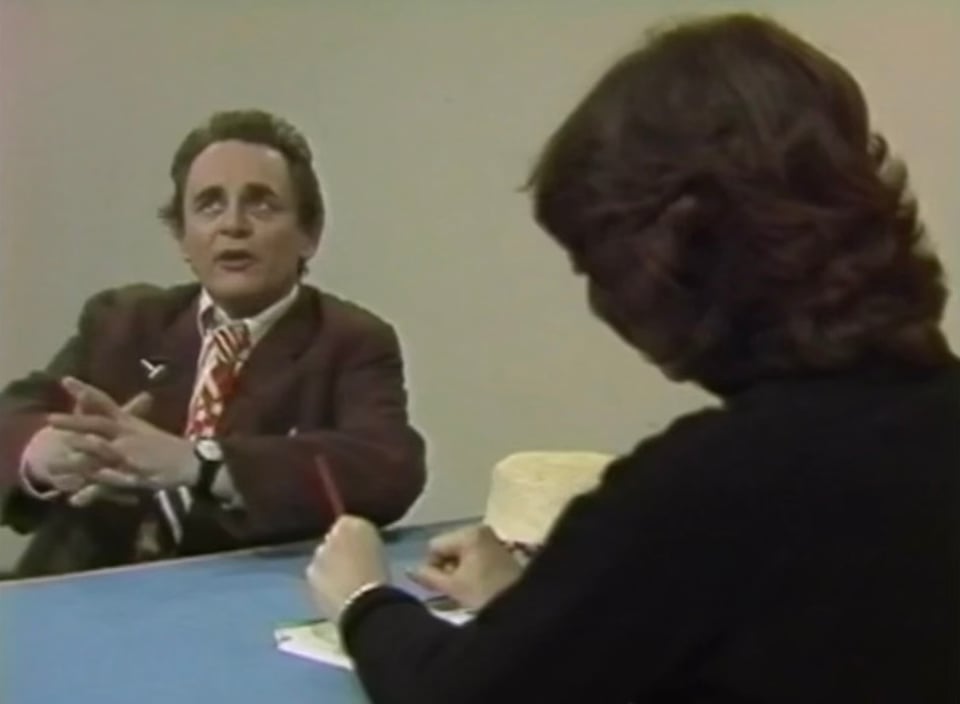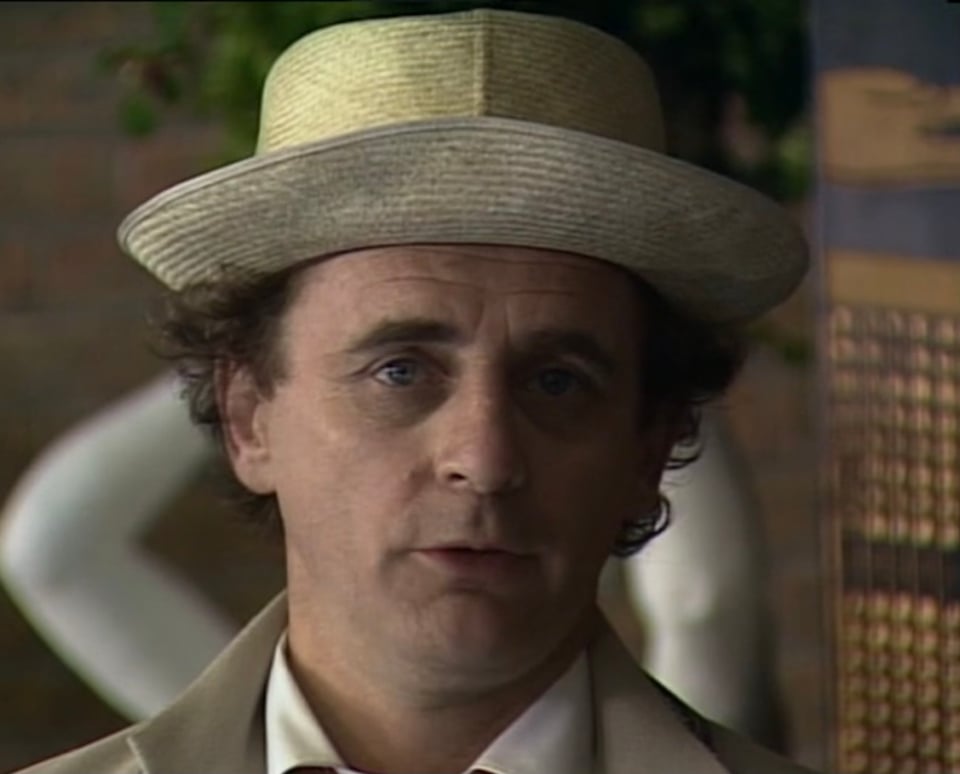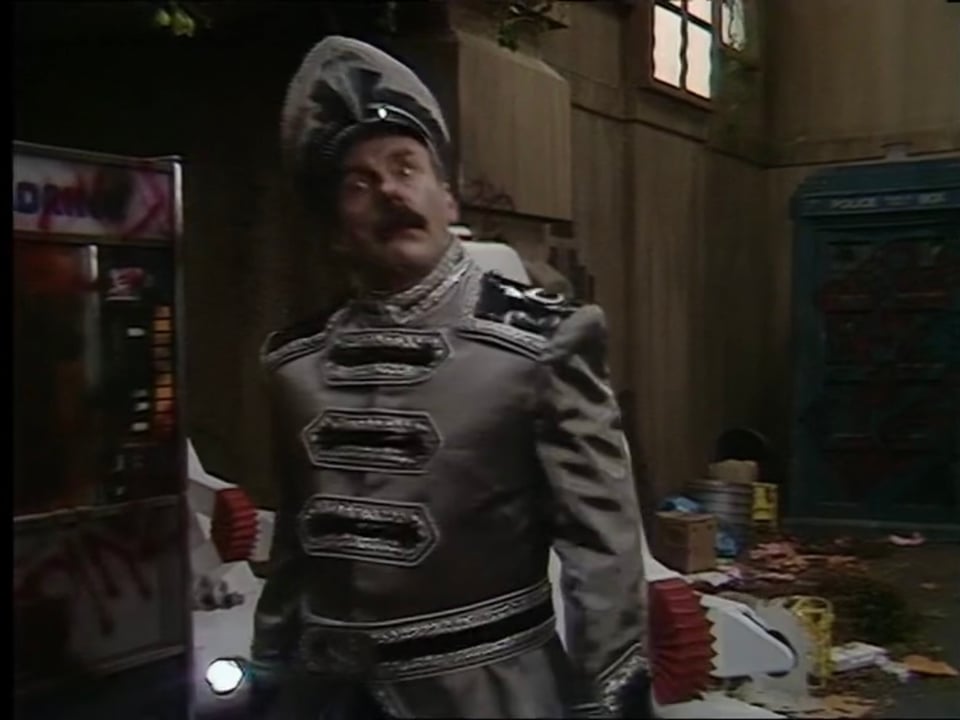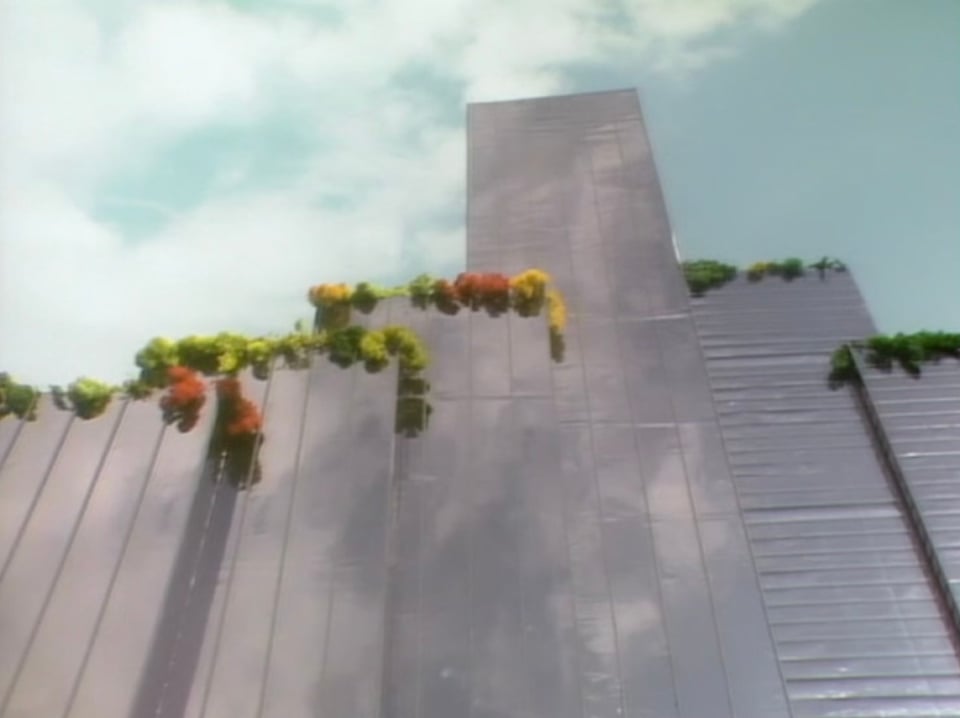Paradise Towers
"Let's clean up the ghetto"
Finding new writers for Doctor Who has never been easy. In 1978 Douglas Adams, determined to bring in fresh voices, worked with writers as different as Sarah Dunant and Allan Prior on stories that didn’t reach the screen. In the end circumstances meant he wrote two serials himself, one a rewrite of David Fisher’s second story of the season (and Fisher’s fourth in two years), and commissioned stories from his predecessor as script editor Anthony Read and two people, Bob Baker and Terry Nation, who had quite literally been writing for Doctor Who since before Adams himself left school.
That context makes it, I think, all the more worth remarking upon that the second to fourth stories of 1987, the first three serials commissioned by Doctor Who’s newly minted script editor Andrew Cartmel, are all by writers new to Doctor Who.
Cartmel had come to Doctor Who from the BBC Script Unit, a project set up to find new writers, which commented on and returned unsolicited script submissions. (It would be useful, if ultimately inaccurate, to think of it as a 1980s version of the current BBC Writers - itself perhaps better known under its previous name, BBC Writers Room).
Cartmel was keen to bring those whose work he’d read and enjoyed in the Script Unit with him onto Doctor Who. It’s therefore significant that the three new writers whom he commissioned for 1987’s Doctor Who, Stephen Wyatt, Malcolm Kohll and Ian Briggs were not simply new to Doctor Who, they were new to television itself, with only Kohll having any produced TV credits, and that for additional sketch material for OTT, Central television’s late night version of Tiswas.
But even if Cartmel had not had both the enthusiasm and passion of youth on his side, even if he’d not been dreaming big, he didn’t really have much choice. There was not, in the first weeks of 1987, a great stable of Doctor Who writers to fall back on, as there had been in 1979. Of those who had written for the series since the turn of 1980s, most were more associated with outgoing script editor Eric Saward (who had walked off of the show in a rage in the middle of 1986) than Cartmel’s new boss, continuing producer John Nathan-Turner. JNT was, in any case, firmly of the opinion that after too long working on Doctor Who any creative figure became “Who-ed Out”.
It was a condition in which he would, if pushed, admit he found himself, after seven calendar years and six series at the helm. But he didn’t want to be there. He was trapped, a situation he would pass off in interviews with the fan-enraging comment that he’d “…been persuaded to stay”. It was perhaps this that meant Nathan-Turner gave Cartmel more leeway, and seemingly more creative control, than he had his previous script editors, and it is arguably not fanciful to, as Cartmel himself has in recent years, refer to the script editor as “script show runner” during the final two years of twentieth century Doctor Who’s production.
JNT knew that he was working on a kind of relaunch of Doctor Who and he was embarking on a substantial aesthetic overhaul as well as preparing to cast a new Doctor, but it was Cartmel’s input, and his determination to bring through new and younger writers, his seeing himself as the vanguard of a new generation of television writing talent, that would mean that the renovation JNT was embarking on would be more than cosmetic. Between them the pair were going to, as they both said contemporary interviews, get Doctor Who ready to go “into the 1990s.” Even if the series itself might not reach the new decade alive.
It’s a measure of how in sympathy Nathan-Turner and Cartmel could be (although not always were) that the initial approach to script unit alumnus Stephen Wyatt was made by Nathan-Turner rather than Cartmel, and before the latter was appointed. Wyatt had a “calling card” script, Claws, a spec about the bitchiness and rivalry between pedigree cat breeders, which Nathan-Turner and Cartmel had both separately read and enjoyed. It was Cartmel who took the meeting that JNT arranged and at it, or a later one, found himself explaining to Wyatt that his ideas for Doctor Who, based in part on viewing The Trial of a Time Lord, were all wrong for the series going forward. He didn’t like them, but he did like Claws. Could they come up with a Doctor Who idea that was more like Claws?
At some point JG Ballard’s novel High Rise (1975), a parable about urban decay, was mentioned, and while the influence of the book on the finished serial is disputed, the idea of a Doctor Who story set in a tower block falling into disarray took hold. It would be a tower block on another world, of course, and there would be monsters and a master villain who was behind the thinly veiled social problems presented onscreen. It was a Doctor Who story, after all. But the key idea had been found.
Wyatt wrote the first episode of Paradise Tower (at the time, the title was in the singular) in a week, without much idea of how the rest of the story would unfold. He did so before Sylvester McCoy was cast as the Doctor, and even before he had formally auditioned for the part. A commission for the final three quickly followed, along with a videocassette of McCoy’s audition for the part once it had actually been recorded.

Wyatt had an advantage over the other writers for the 1987 series in that he had, coincidentally, seen McCoy in the title role of Adrian Mitchell’s The Pied Piper at the National Theatre. This was the performance that had prompted Nathan-Turner to seriously consider McCoy for the Doctor in the first place, after he had been suggested by both the actor’s agent and fellow BBC producer (and 1960s Doctor Who alumnus) Clive Doig who had worked with McCoy and long thought him ideal for the role.
Interviewed by the fanzine dwb towards the end of 1987 McCoy would note that as an actor he’d had effectively two mutually exclusive, but simultaneous, careers. In television he’d largely worked in children’s series, such as Jigsaw (1979-84, produced by Doig) and comedy, whereas in the theatre -
“… there was a parallel career going on... but because television producers and directors hardly ever come to the theatre, and theatre people hardly ever know what is happening on TV (because they are always working), there is very little cross-fertilisation. So I had two careers going on: one in the theatre, which was classical-orientated such as Shakespeare, Beckett, Brecht… and I was paying for my mortgage in a sense by doing children's stuff on television. Children are a very honest audience, you can't be patronising to them. In the theatre I've also done children's stuff as well, but mostly it's been adult.”
In the summer of 1986 McCoy had been a member of Richard Eyre’s Shakespeare company - headed by Vanessa Redgrave - immediately before Eyre took over the National Theatre, to which McCoy followed him. It’s probably telling that in terms of reactions to McCoy’s casting, dwb had concentrated on the disgrace of a children’s television actor getting the role, The Sun had led with “Sly once stuffed ferrets down his trousers” and The Times went with “National Theatre Actor Cast as Doctor Who”.
(It was incidentally, during the West End run of Eyre’s company’s productions of The Taming of the Shrew and Julius Caesar, which shared a cast, where McCoy would later recall reading in a newspaper that Eon productions were actively seeking a new James Bond for a film due to begin production towards the end of the year, and that this prompted him to remark to the company’s lead actor, Timothy Dalton, that “You should go for that. You’d make a great James Bond.” It’s one of those stories that sounds too good to be true, but that West End run took place in May - July 1986, there was public speculation about Roger Moore’s successor during that period, and Eon Productions, who had previously discussed the role with Dalton in 1979 and on at least one occasion prior, made another approach to the actor in August. This is one of those rare actorly anecdotes that adds up.)
Getting Doctor Who was something that would bring McCoy’s two parallel careers together in a single role, and in that context it’s worth noting that McCoy’s performance in Paradise Towers is very different to that in Time and the Rani, some of which was recorded only weeks before. It’s a smaller, more melancholy, more fretful performance.

Whereas Time and the Rani leans more into the Eureka or Tiswas side of McCoy’s work, by Paradise Towers the actor has had time to stop and think, to rein in what he was doing, and realise the similarity between the Doctor and those Shakespearean clowns he’d already played. The Doctor of this story is, while on the lighter edge of the character’s range, recognisably the one McCoy plays in his most recent television appearances as the Doctor, The Power of the Doctor (2022) and Tales of the TARDIS (2023) in a way that of Time and the Rani isn’t.
There are other ways that Paradise Towers is profoundly different from Time and the Rani. Whereas the earlier serial looked to make its story identifiable to the audience through references to pop culture and threatening the earth, even if it was from a distant planet, Paradise Towers looks for relevance by holding up a distorting mirror to the country in which the programme was made. This is a theme that would continue under Cartmel who had, after all, impressed JNT at his interview by answering the question “If you could do one thing with Doctor Who what would it be?’ with the words “Bring down Thatcher”.
Like I said - dreaming big.
Because Paradise Towers is of the Britain of the 1980s, while not being set in the Britain of the 1980s. A ruined high rise housing block with graffitied walls and teenage gangs and a police / security force that is both authoritarian and ineffectual. The older generation of legitimate residents of the towers, owner-occupiers indeed, have turned to cannibalism, literally consuming the young as a resource, in a metaphor that’s as striking today as it was in 1987. They also never stop going on about the bloody war as they do so.
Equally strong is that, in a trick common in the Doctor Who of Robert Holmes but which Wyatt seems to have alighted upon independently, the threat to the world in which the story is set comes both literally and figuratively from its foundations. The society is wrong from the bottom up, both in that its foundational principles are unsound, and that there’s literally a monster in the basement. While fans of more overt (party) political subtexts might note that the Kangs are coloured Red, Blue and Yellow, and while the Doctor instantly sides with the Reds, the Yellows have recently been wiped out.
The world these characters inhabit is effectively realised. While the corridors are wide and spacious, and hint at art deco in their design, they’re also dirty and dilapidated, while the sets’ multiple vertical levels convey genuine scale. It’s not realistic, of course. But realism is only one mode available to television drama.
Paradise Towers view of the mid to late 1980s is subjective and, in a sense, impressionistic. Conveying an idea of a time through design. At times that design seems as much like experimental or children’s theatre as it ever does mimetic television drama. It is, as I said, not realistic. But it feels real.
Pre-teen me didn't consider any of this at the time, of course, but during the weeks this story was transmitted, and for several afterwards, both I and my friends at school drew the Towers cleaning robots on our exercise books, and attempted to build one out of Lego. Which is a sign that Doctor Who was attempting, and perhaps succeeding, in reaching multiple, if overlapping audiences.
There was another audience who really mattered to the Doctor Who production office, their BBC superiors. BBC Head of Drama Jonathan Powell, often and with good reason thought of as Doctor Who’s nemesis, wrote to Cartmel after transmission praising the serial. If we are to assume good faith on his part, and I would rather assume it on the part of almost anyone, then that suggests that there is conceivably a version of Doctor Who that Powell could, if not like, then get on board with, and see the merit of. Paradise Towers is grand and hyperbolic, it has big themes and big performances. It’s about something. It also has a cast strong enough to support that approach.
Yes, producer Nathan-Turner fretted in the studio about Guest Star Richard Briers’ performance as the Chief Caretaker, particularly once he’s possessed at the climax to Part Three, and which the actor declined to tone down when asked, but there are bigger and odder performances all the way along Doctor Who. Briers’ turn is at least sufficiently different from the way he plays the Chief in the first three quarters of the story that we know what he’s doing is deliberate. A choice. If his idea that the Chief is now dead, and that what we’re watching is someone trying and failing to animate a corpse (hence the lumbering gait, lolling head and strangulated speech) is not to your taste, at least it has a logic behind it.

On paper, Paradise Towers has one of the best casts of any Doctor Who story. Not just Briers, but Olivier winner Elizabeth Spriggs, Bafta winner Brenda Bruce, stage great and Radio 4’s Sherlock Holmes, Clive Merrison. All get good material, in part because Wyatt’s scripts have a sheer pleasure in language rarely present in twentieth century Doctor Who outside the work of Robert Holmes.
The scene in which the Doctor convinces the Caretakers to set him free by lying about the contents of the rule book they have sworn to uphold is fantastic encapsulation of what’s great about the story. Its anti-authoritarianism, its contempt for intellectual inflexibility, and that it is filled with good actors willing to play those for comic despair without blinking. Because Paradise Towers is, yes, a comedy. A black comedy about matters of enormous seriousness. Which I’d take over a dramatic piece about the absolutely trivial any day of the week. Even at Monday in the unenviable slot of 19:35. Not just against Coronation Street, but giving the other television institution a five minute head start.
The Robert Holmes comparison is appropriate, as much as it would have appalled the fans who read dwb at the time. His Carnival of Monsters and The Sun Makers are two of the very few Doctor Who stories before Paradise Towers to share very much with it at all, in terms of approach. And I do mean very few before it, because after it? After it there are more than a dozen, and not just in the remainder of the McCoy / Cartmel era. There are hints of Paradise Towers in The Long Game (2005), The Idiot’s Lantern (2006), The Beast Below (2010) and many others. For that matter, you can see a clear influence from Paradise Towers as recently as Space Babies, an episode of Doctor Who transmitted less than a week ago as I write this, more than 35 years after Paradise Towers went into studio.
To “Build High for Happiness”, you need to dream big.
